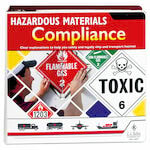“Hazmat Transportation” is a rather wide-reaching topic. However, there are three main areas all organizations involved in transporting hazardous materials must pay specific attention to:
- Hazmat Training
- Preparing to Transport
- Transporting Hazardous Materials
Each of these areas is critical to the safety and success of every hazardous materials load.
To help safeguard everyone involved, the DOT has developed special preparation, transportation, and handling requirements known as the Hazardous Materials Regulations (HMR).
News and Regulatory Info
Transporting Hazmat Solutions
-
Hazmat Training
Provides critical information on hazardous materials regulations. Choose from a variety of formats.
-
J. J. Keller® Compliance Network
COMPLIANCE NETWORK is a premier online safety and compliance community, offering members exclusive access to timely regulatory content in transportation (DOT), workplace safety (OSHA), environment (EPA), and human resources (DOL).
-
Handbooks & Pocketbooks
Cover a wide range of critical topics and give your drivers fast access to the compliance info they need, including 49 CFR Parts 100-199.
-
Bills of Lading & Shipping Papers
Help you meet DOT requirements for proper shipment documentation.
-
Hazardous Materials Reference Books
Get fast, easy access to DOT's word-for-word Hazmat regs and "how-to-comply" guidance.
-
Placards and Labels
Browse our vast selection of placards and labels that meet strict regulatory requirements. Includes Lithium Battery labels and markings. Try our flip placard finder to quickly find the flip placards you need!
-
Hazardous Materials Compliance & Safety Programs
Our experts work directly with you to help improve compliance.
-
FleetMentor® Tool
The online toolbox and advisor that will help you cover all areas of the CSA BASICs.
-
Emergency Response Guidebook (ERG)
The ERG helps satisfy DOT requirements that hazmat shipments be accompanied by emergency response information.
-
J. J. Keller® Encompass® Vehicle Tracking
The Encompass® Platform offers an easy-to-use GPS vehicle tracking solution that gives you near real-time visibility on all your vehicles without any driver interaction.
-
J. J. Keller® Encompass® Fleet Management System
The industry's most comprehensive fleet compliance solution for driver and vehicle compliance and performance tracking.
"We feel that we get more for our money because of the high quality of J. J. Keller products. We use our hazardous materials products every day, so our trust in J. J. Keller expertise and experience is vital"
Essential Hazmat Transport Information
Hazmat Training
The Hazardous Materials Regulations (HMR) require that hazmat employees be trained, tested, and certified regarding the parts of the regulations that pertain to their job functions.
It’s an employer’s responsibility to determine which specific parts of the HMR apply, to make sure the hazardous material training focuses on those specific areas and to ensure employees receive the DOT hazmat training they need.
The HMR established these categories of hazardous material training:
- General Awareness/Familiarization Training
- Function-Specific Training
- Safety Training
- Security Awareness Training
- In-Depth Security Training
- Modal-Specific (Driver) Training
For more detailed information on the hazardous materials training requirements, see 49 CFR, part 172, Subpart H and 49 CFR 177.816.
View the hazmat safety training solutions you need to help meet the HMR and maintain compliance.
Preparing to Transport
Requirements in the Hazardous Materials Regulations (HMR) apply to anyone who prepares or offers a hazardous material for transportation in commerce.
Pre-transportation functions include, but are not limited to:
- Determining the hazard class of a hazardous material
- Selecting hazmat packaging
- Filling a hazmat package
- Marking or labeling a hazmat package
- Preparing a shipping paper
- Providing and maintaining emergency response information
- Reviewing a shipping paper to verify compliance
- Certifying that a hazardous material is in proper condition for transport
- Loading, blocking, and bracing hazmat packages
- Segregating a hazardous materials package
- Selecting, providing, or affixing hazmat placards
View solutions and services to help you and your organization achieve and maintain compliance in regard to the preparing of hazmat for transportation.
Transporting Hazardous Materials
In most situations, transportation begins when a carrier takes physical possession of the hazardous material for the purpose of transporting it in commerce and continues until it is delivered to its destination.
Transportation of a hazardous material in commerce includes the following:
- Movement
- Loading
- Unloading
- Storage during transport
Hazmat transporters also need to be aware of Hours of Service regulations. Visit our Hours of Service compliance topic page for more information.
View solutions and services available to you regarding the safe and compliant transporting of hazmat.











